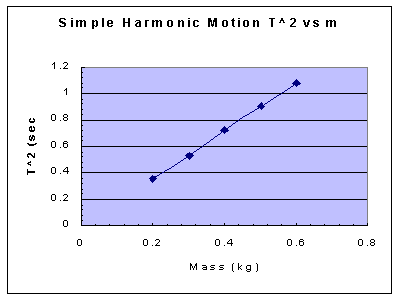


 |
Please type your LAST NAME and LAST FOUR SS# digits (eg: Smith3256):
I received no help from anyone on this assignment.

1. The graph above is a plot of the period (T)2 vs the mass of an object undergoing simple harmonic motion. Find the value of the spring constant (k) for this system.
2. A box attached to a spring is undergoing simple harmonic motion. The box has a mass of 2kg and the spring constant is 200N/m. What is the period of oscillation for this system?
3. Galileo discovered that simple pendulums could be used to keep time. A typical grandfather clock pendulum has a period of 2 seconds. What should be the length of such a simple pendulum taking g to be 9.8m/s2. Does the mass make a difference?
3. In the experiment on Friday you will verify the law of energy conservation by releasing a glider along a tilted air track and comparing the change in potential energy of the glider to the change in kinetic energy. The potential energy change will be calculated from the difference in elevation H between two points, the change in kinetic energy will be obtained from a direct velocity determination by the position sensor.
A schematic diagram of the experiment looks like this:

You will be asked to plot the change in kinetic energy versus the change in potential energy for several releases of the glider from different elevations.
Will that graph as a straight line? Why?
What will be the slope of the line?
You may change your mind as often as you wish. When you are satisfied with your responses click the SUBMIT button.